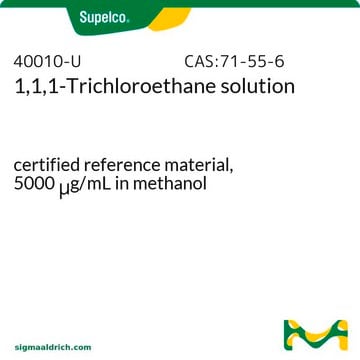If this product has an expiration or retest date, it will be shown on the Certificate of Analysis (COA, CofA). If there is no retest or expiration date listed on the product's COA, we do not have suitable stability data to determine a shelf life. For these products, the only date on the COA will be the release date; a retest, expiration, or use-by-date will not be displayed.
For all products, we recommend handling per defined conditions as printed in our product literature and website product descriptions. We recommend that products should be routinely inspected by customers to ensure they perform as expected.
For products without retest or expiration dates, our standard warranty of 1 year from the date of shipment is applicable.
For more information, please refer to the Product Dating Information document: https://www.sigmaaldrich.com/deepweb/assets/sigmaaldrich/marketing/global/documents/449/386/product-dating-information-mk.pdf
Kluczowe dokumenty
270393
Tetrachloroethylene
suitable for HPLC, ≥99.9%
Synonim(y):
PCE, Perchloroethylene
Wybierz wielkość
213,00 zł
Wybierz wielkość
About This Item
213,00 zł
Polecane produkty
klasa czystości
HPLC grade
gęstość pary
5.83 (vs air)
ciśnienie pary
13 mmHg ( 20 °C)
19 mmHg ( 25 °C)
Próba
≥99.9%
Formularz
liquid
oczyszczone przez
glass distillation
metody
HPLC: suitable
zanieczyszczenia
<0.050% water
pozostałość po odparowaniu
<0.0005%
kolor
APHA: ≤10
współczynnik refrakcji
n20/D 1.505 (lit.)
bp
121 °C (lit.)
mp
−22 °C (lit.)
gęstość
1.623 g/mL at 25 °C (lit.)
λ
H2O reference
absorpcja UV
λ: 290 nm Amax: 1.00
λ: 295 nm Amax: 0.30
λ: 300 nm Amax: ≤0.20
λ: 305 nm Amax: 0.10
λ: 350 nm Amax: 0.05
λ: 400 nm Amax: 0.03
Zastosowanie
food and beverages
ciąg SMILES
Cl\C(Cl)=C(\Cl)Cl
InChI
1S/C2Cl4/c3-1(4)2(5)6
Klucz InChI
CYTYCFOTNPOANT-UHFFFAOYSA-N
Szukasz podobnych produktów? Odwiedź Przewodnik dotyczący porównywania produktów
Powiązane kategorie
Zastosowanie
- Dyspersyjna mikroekstrakcja ciecz-ciecz jako nowe podejście do wzbogacania w specyficznej dla związku analizie izotopów węgla chlorowanych fenoli...: W niniejszym badaniu wprowadzono nową technikę mikroekstrakcji obejmującą tetrachloroetylen, zwiększającą czułość i specyficzność analizy izotopów węgla w złożonych próbkach środowiskowych (Martin et al., 2024).
- Synteza estrów węglanowych z tetrachloroetylenu metodą fotochemiczną in situ...: Badania te przedstawiają nowatorską fotochemiczną metodę syntezy estrów węglanowych z tetrachloroetylenu, demonstrując jej potencjał w syntetycznej chemii organicznej i zastosowaniach przemysłowych (Higashimura et al., 2024).
Hasło ostrzegawcze
Warning
Zwroty wskazujące rodzaj zagrożenia
Zwroty wskazujące środki ostrożności
Klasyfikacja zagrożeń
Aquatic Chronic 2 - Carc. 2 - Eye Irrit. 2 - Skin Irrit. 2 - Skin Sens. 1 - STOT SE 3
Organy docelowe
Central nervous system
Kod klasy składowania
6.1C - Combustible acute toxic Cat.3 / toxic compounds or compounds which causing chronic effects
Klasa zagrożenia wodnego (WGK)
WGK 3
Temperatura zapłonu (°F)
No data available
Temperatura zapłonu (°C)
No data available
Wybierz jedną z najnowszych wersji:
Masz już ten produkt?
Dokumenty związane z niedawno zakupionymi produktami zostały zamieszczone w Bibliotece dokumentów.
Klienci oglądali również te produkty
-
How can I determine the shelf life / expiration / retest date of this product?
1 answer-
Helpful?
-
-
How is shipping temperature determined? And how is it related to the product storage temperature?
1 answer-
Products may be shipped at a different temperature than the recommended long-term storage temperature. If the product quality is sensitive to short-term exposure to conditions other than the recommended long-term storage, it will be shipped on wet or dry-ice. If the product quality is NOT affected by short-term exposure to conditions other than the recommended long-term storage, it will be shipped at ambient temperature. As shipping routes are configured for minimum transit times, shipping at ambient temperature helps control shipping costs for our customers. For more information, please refer to the Storage and Transport Conditions document: https://www.sigmaaldrich.com/deepweb/assets/sigmaaldrich/marketing/global/documents/316/622/storage-transport-conditions-mk.pdf
Helpful?
-
Active Filters
Nasz zespół naukowców ma doświadczenie we wszystkich obszarach badań, w tym w naukach przyrodniczych, materiałoznawstwie, syntezie chemicznej, chromatografii, analityce i wielu innych dziedzinach.
Skontaktuj się z zespołem ds. pomocy technicznej










